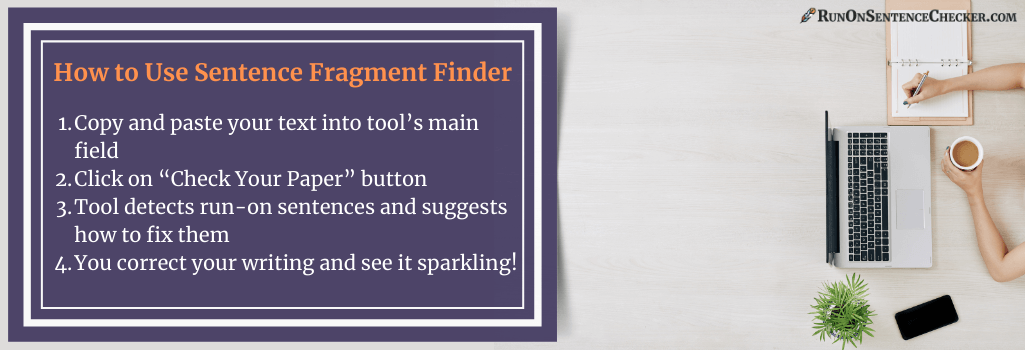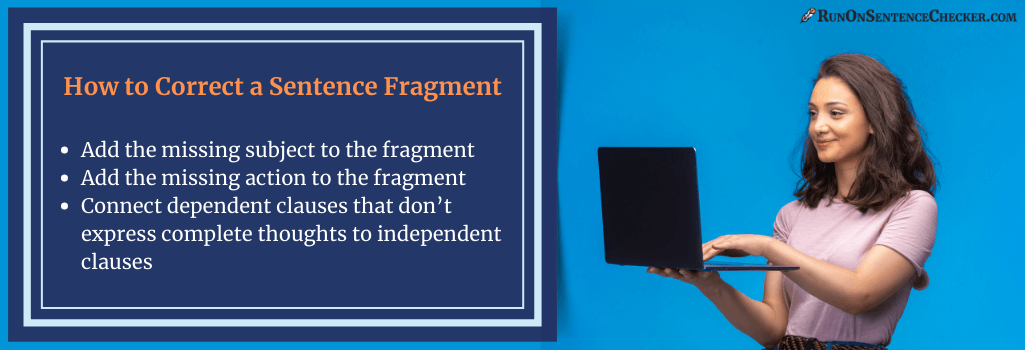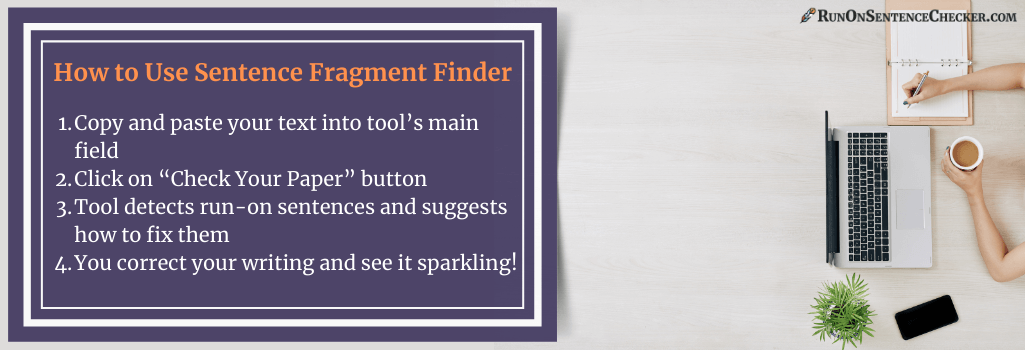What Is a Sentence Fragment?
A sentence fragment lacks at least one of the three components that make up a complete sentence, those being a subject (the actor in the sentence), a verb and a complete thought. You can identify a sentence fragment by observing that a component is missing or by using an incomplete sentence checker. The following are 4 types of sentence fragments:

- No subject. If a subject is lacking then it is an incomplete sentence. Example: “Ran home faster than a greyhound.” The reader doesn’t know who ran as the subject is missing, making it a sentence fragment
- No verb/wrong verb form. A sentence needs action to be complete. Example: “My favorite actor.” We aren’t told what it is the actor does. Without action the sentence is incomplete.
- Subordinators/relative clauses. A clause that begins with a subordinator (although, because, while etc) or a relative pronoun (who, where, that, etc) is a dependent clause and can’t stand alone. Example: “Although there are many topics to discuss.” The clause begins with a subordinator and needs an independent clause to complete the thought so is an incomplete sentence.
- Participle phrases. Participle phrases will often begin with a verb that ends in “ed”(past) or “ing”(present). Example: “Confused by the assignment.” This phrase doesn’t complete thought on its own so it is an incomplete sentence.
Identifying incomplete sentences can be confusing but using a “is this a fragment checker” can definitely simplify the process.
Identifying and Correcting Sentence Fragments
Many people overlook run on sentences and sentence fragments because they don’t know the difference between an independent clause and a dependent clause. They may assume that because a clause contains a subject and verb that it is a complete sentence but neglect to consider if it is expressing a complete thought. A good start to avoiding sentence fragments and run on sentences is to learn what it takes to make an independent clause:
- Make sure the sentence contains a subject. The subject is the person or thing performing the action in the sentence.
- The sentence requires a verb. The verb is the action being performed by the subject
- The sentence must contain a complete thought. If a sentence doesn’t complete thought so that it can stand on its own it is incomplete
Once identified, there are several ways how to correct a sentence fragment:

- Add the missing subject to the fragment. Example: “Ran home faster than a greyhound.” Add the subject “Joe”. “Joe ran home faster than a greyhound.” This makes the sentence fragment a complete sentence.
- Add the missing action to the fragment. Example: “My favorite actor.” Add the action “starred” “My favorite actor starred in many movies.” The sentence is no longer a fragment.
- Connect dependent clauses that don’t express complete thoughts to independent clauses. Example: “Whenever I walk to the store.” This doesn’t express a complete thought. Add the independent clause “I buy ice-cream.” “Whenever I walk to the store I buy ice-cream.” The sentence now expresses a complete thought.
You can find plenty to read about how to fix run on sentences and fragments but still have trouble when it comes time to do it yourself. Another option for how to correct a sentence fragment is to make use of a fragment sentence checker to identify and correct mistakes.
About Our Fragment Fixer and Run on Sentence Checker
Our run on and fragment checker greatly simplifies the process of identifying and correcting incomplete sentences and run on sentences. It identifies the errors for you in a matter of seconds and provides you with suggestions for how the mistakes can be corrected. This writing tool isn’t just a fragment fixer. It also functions as a fused/run on sentence and comma splice checker, identifying these types of mistakes and providing suggestions on correcting them. However, this only scratches the surface of what our sentence fragment corrector can do. It has a number of other features that you will find useful when it comes time to edit and polish your text. These include a spelling checker, a punctuation checker, a dictionary checker and various checks on your grammar usage.
The sentence fragment finder also informs you if you are writing in active voice or passive voice and suggests adjustments you can make to ensure you are using the correct voice for your purpose. In addition the sentence fragment identifier examines the tone of your text as well as your word usage. Additional benefits of using our run on sentence tester include:
- Easy access. It can be used anywhere you can access the internet
- Speed. Depending on the length of your text it only takes a few seconds to a minute to complete an analysis and issue a report
- Works with any type of text. You can use our fragment finder for academic papers, articles, letters, emails, blog posts or virtually any other type of text
With its many editing features and the other benefits it offers our fragment identifier is the obvious choice when it comes time to proofread and edit you text regardless of its intended purpose.
How to Use Our Sentence Fragment Finder
With all the features it offers, you might expect our fragment corrector to be a little complicated to use but that is not the case at all. As a matter of fact no technical expertise is required. You can have your text analyzed and receive a report by following these simple steps:

- Enter your text. Text can be entered by simply copying and pasting it into the provided field. You may also type directly into the field.
- Start the analysis. Text analysis is initiated by clicking the button
- Receive your report. In a short time, you will receive a report identifying sentence fragments and other errors in your text. The report includes suggestions on corrections and adjustments that will improve your text.
- Complete the suggested corrections and adjustments.
It is that simple to improve your writing to the highest standards in no time at all.





